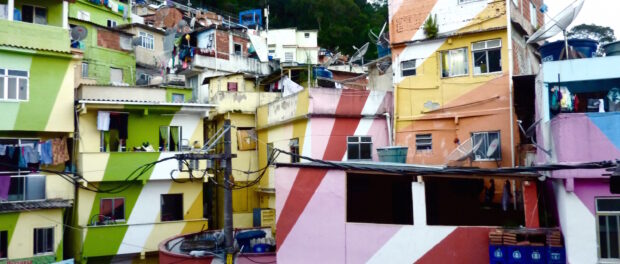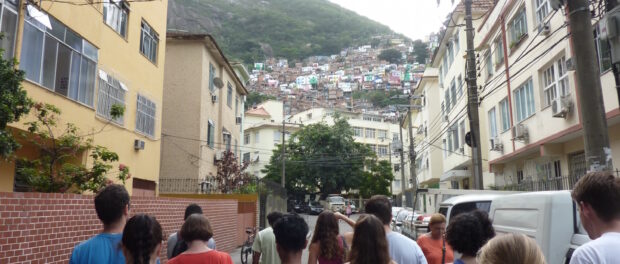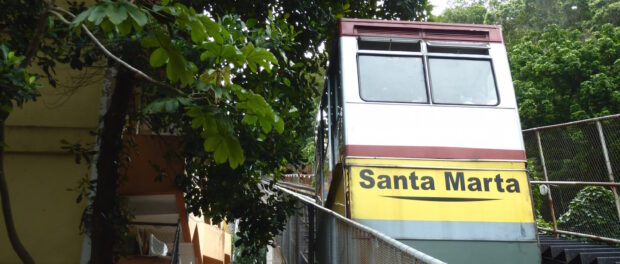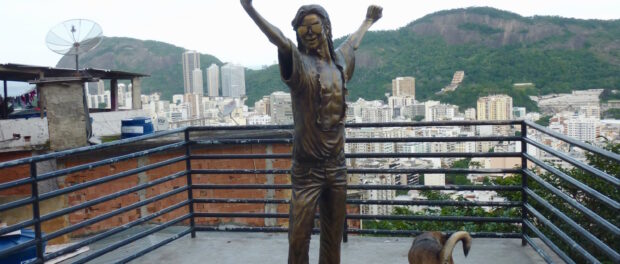
On Monday June 1, police, municipal guards and city officials crowded into the Santa Marta favela to destroy a number of homes, leaving residents confused, panicked, and without shelter due to the delay in promised public housing construction. Last month, RioOnWatch took a tour of Santa Marta led by Vitor Lira, a 5th generation resident of the community. In addition to leading tours to show the reality of life in the neighborhood, Vitor plays a vocal role in community activism and offered insight into the ongoing transformations and pressures of eviction.
Vitor stands leaning over the railing of the tram platform and casts his hardened gaze further up the seemingly vertical mountain slope. His backdrop is quite miraculous—a patchwork of unique and colorful homes hugs the forested hillside, and Rio’s famous Christ the Redeemer statue stands directly above with arms outstretched. The rest of the tour group joins on the platform, winded from choosing hundreds of steps rather than waiting for the next tram.
“My house is right up there,” Vitor says to the group and points to where the brick homes of Santa Marta, the steepest of Rio’s thousand favelas, meet the sheer rock face of the hillside. Birds fly at eye-level leading one’s gaze down winding narrow paths and stacked homes, over the tops of tall apartment buildings and Rio’s lagoon, and out to the Atlantic. This view is more than just home to Vitor, whose family was some of the first to settle into the favela in the 1930s. This view represents over five generations of family and friends who have together built a vibrant community, witnessed the rapid expansion of the city below and, more recently, faced the government’s threats to take it all away.
Vitor’s tour began at the base of the favela, where a line of chatting elderly residents, mothers, and school children was forming to take the tram up the hillside. Two teenage boys carried heavy bags of red corrugated bricks and leaned them against the “service” side of the tram. Built in May 2008, the tram is a critical part of Santa Marta and according to Vitor, “the only successful form of assistance the government has provided for the community.” He is quick to point out that for as often as the tram runs, it just as frequently breaks down, leaving community members to walk up and down the steep steps with construction supplies, groceries, schoolbooks, and garbage. The first round of evictions in Santa Marta were due to the construction of this tram; the following round came after the installation of the Pacifying Police Unit (UPP).
In December 2008, Santa Marta became Rio’s pilot favela for the highly publicized UPP program and is often used as a shining example of success for the pacification policy. Since then, Santa Marta has become a ‘chic’ tourist attraction and the subject of a TED Talk featuring brightly painted façades of a beautification initiative led by Dutch artists. For residents like Vitor however, “the UPP has done everything to allow tourists to come into the community, but it has done nothing for me.” Like many entrepreneurial thinkers in the community, Vitor seized upon this opportunity to show outsiders a “truer” side of Santa Marta.

As a tour guide, Vitor reveals every intense passion and the emotional struggle he endures to sustain his life in Santa Marta. He wants visitors to see through the eyes of residents, for whom a colorful coat of paint exemplifies a gilded reality of evictions, threats, and lack of investment. For years, Vitor and his fellow community members have fought against the government’s unfounded demands of eviction, especially at the highest levels of the favela. Deemed too “risky” for habitation, the City ordered residents at the peak of Santa Marta to leave behind over 80 years of history and relocate to a public housing unit. Residents formed an activist group and were able to successfully hold on to their land rights by bringing in the expert testimony of a local geology professor. He proved that their homes are not the “dangerous dwellings” the government claims them to be, but are in fact safer than the proposed setting of relocation.
Vitor also led a vocal demonstration of around 300 residents in July 2013, protesting evictions and the City’s inadequate attempts to provide basic sanitation and infrastructure. “Because Santa Marta was the first favela to be pacified, the city needs to protect the image of ‘success,’ but fails to meet our needs every single day.” Vitor argues that the UPP’s apt location at the top of the community has not brought the promised safety or security, but instead creates fear and provides a ubiquitous eye for the government to impose its order.

Vitor’s story of government pressure and distrust in police is unfortunately not unique, but is becoming more and more common, and increasingly intense, in the favelas of Rio de Janeiro as the city prepares for the Olympic Games. Just last week, on May 28, Santa Marta’s image of security was challenged when UPP officers exchanged gunfire with suspected drug traffickers.
Vitor ends his tour at another iconic—and appropriate–lookout: the setting of Michael Jackson’s music video, “They Don’t Care About Us.” Michael’s face looks out from a vibrant mosaic on the wall, and his cast-iron statue stands with arms outstretched in pride. “Just look at this view up here,” Vitor admires. “It’s no coincidence that those with the best views in Rio have to fight the hardest against evictions.” This point highlights the unusual socio-geographic features of Rio, as one of the only places in the world where the poorest hold the most coveted and scenic views. It also brings to light a larger issue of land security and the need for a regulated market as the city experiences a resurgence of economic activity and lure of mega-events.
Vitor knows the fight for his land rights will continue, that he may have to resume his role of activism just to remain in the home he has known his whole life. “To work in human rights in Brazil is to put your life at risk,” he states. And yet he demonstrates with dignity and confidence that defending his livelihood and generations of memories is a risk he is willing to take, for a community worth fighting for.
To schedule a tour with Vitor, contact him on Facebook.


